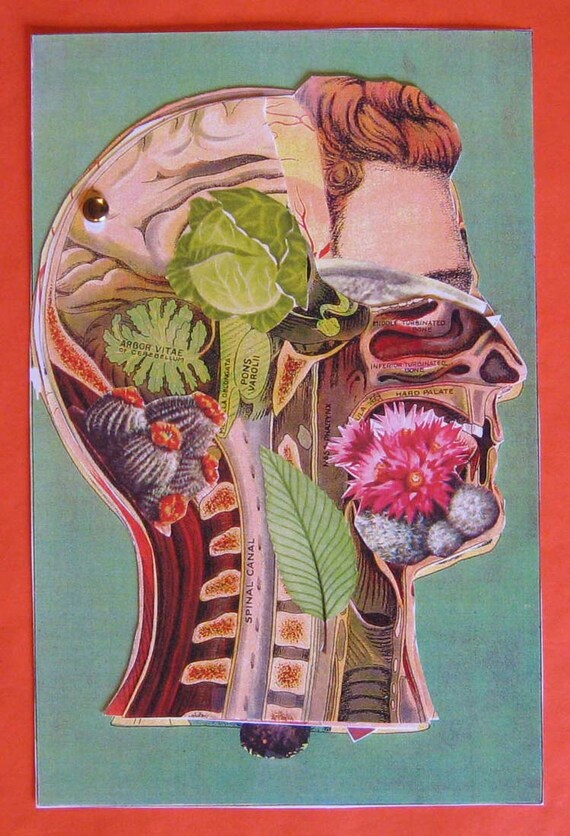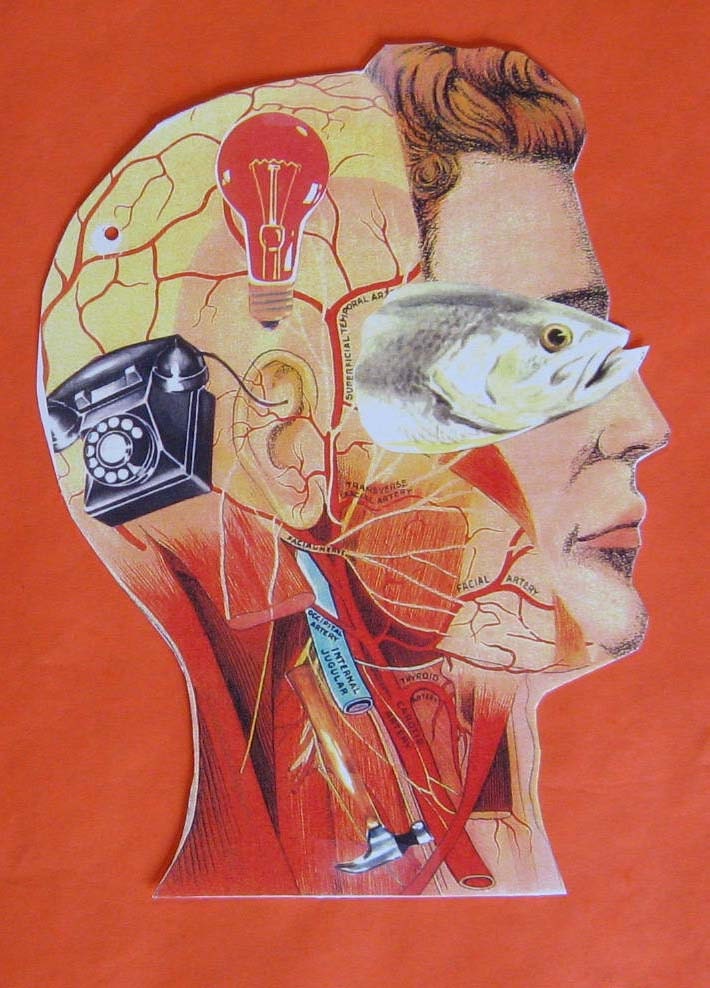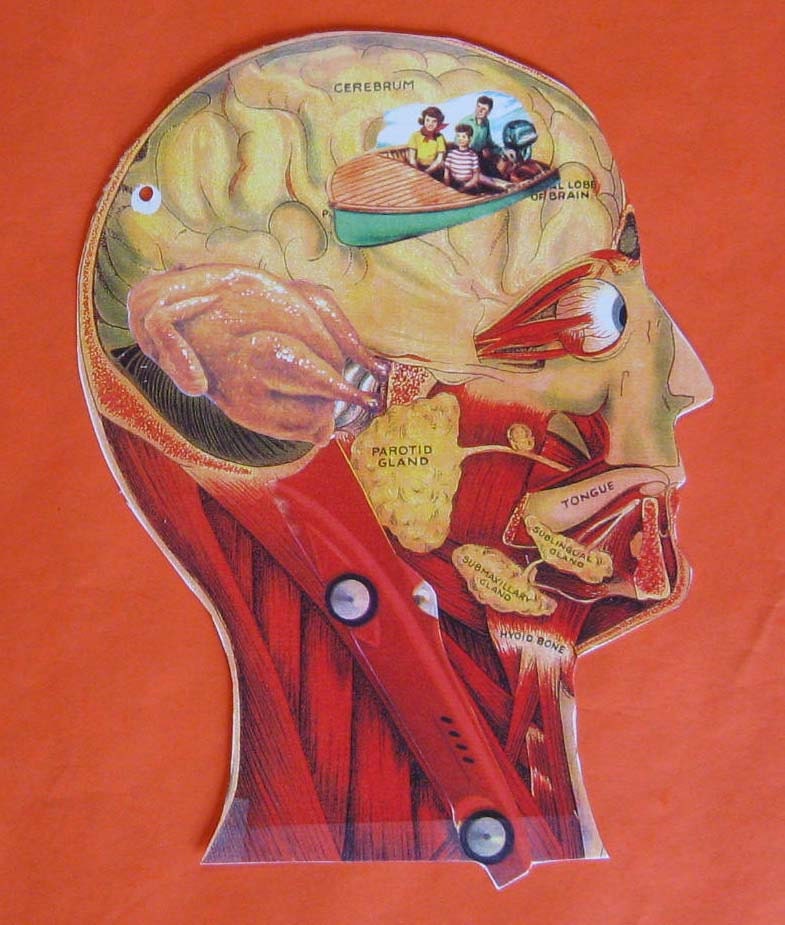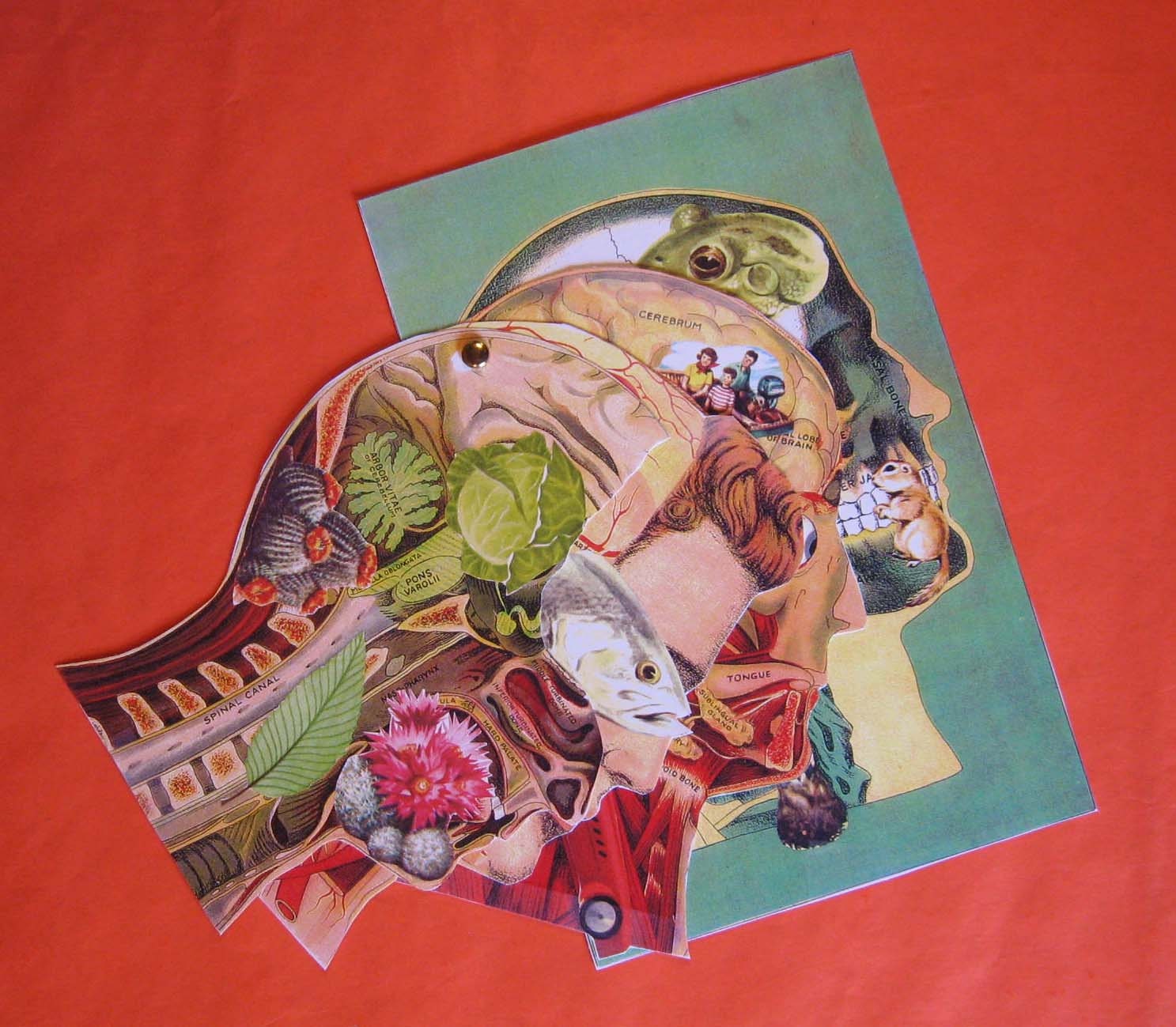Tuesday, July 31, 2012
True Anatomy
From our Etsy shop:
A colorful 5 1/2"w x 8 1/2"h multi-layered chart
of of the true workings of the mysterious human mind. See into the
subconscious where speed boats, roasted turkeys, light bulbs, hammers,
death cap mushrooms, toads, tractors, and small squirrels influence your
dreams and actions. The human psyche revealed in this surreal collage
made from cutting up books!
Tuesday, July 10, 2012
Pistil on Etsy
After a hiatus of several years, we have again started selling some items on Etsy.com, the selling site for crafts and vintage items. Here we are selling our recycled journals made from old library books, vintage children's books, and collage cards which feature collage art made by Sean and I the old fashioned way - scissors, Exacto knife, glue stick and.... cutting up old books. The cards are a mere $3.
I must say I like the way the Etsy storefront shows the thumbnail photos of our books and cards - quite the colorful array. In the future we will be adding more cards - including block printed cards, and possibly some original collage artwork and assemblages.
I must say I like the way the Etsy storefront shows the thumbnail photos of our books and cards - quite the colorful array. In the future we will be adding more cards - including block printed cards, and possibly some original collage artwork and assemblages.
Labels:
blank cards,
cards,
collage,
crafts,
Etsy,
greeting cards
Sunday, July 1, 2012
Ephemera
This weekend I went to an estate sale with my friend Tim. We were planning to go garage saleing, but this being Juneuary in Seattle, it was too rainy for outdoor sales. Sometimes sales advertised as "estate sales" are really just misnamed yard sales with small piles of crap, the sellers not realizing they have to be dead to really qualify for the more esteemed term. This small modest house in the Queen Anne neighborhood was the real thing. There's something a little creepy and sad about estate sales: the literal contents of a person's life-- drawers, closets, shelves laid out for strangers to rummage through and worth only pennies. Since the estate sale was held now, in 2012, you know the person was alive fairly recently, but often their possessions seemed to have stopped changing after a certain date, in this case 1978. So much bright polyester. I went straight to the bookshelves, which were pretty much filled with junk, but interesting junk, nevertheless. For instance, a pamphlet published by Reader's Digest about "Joe's Man Gland." Lots of beat up religious titles, nonfiction pocket books from the sixties, a cool children's ex-library book from the fifties on America's Heritage from the Ancient World, that I actually bought. The books' owner was one of those people who leave lots of little scraps inside their books: coupons, lists, notes, a paper butterfly.
The best find, though, was the Official Program: Treasures of Tutankhamun which was exhibited at the Seattle Center in 1978 - and which is once again exhibiting in Seattle (and there's a really cool giant Anubis statue outside the downtown train station). I remember King Tut mania from around that time period. My fifth grade classroom had a decorated plywood box the kids were supposed to crawl around inside with a flashlight (like archaeologists!), answering questions the teacher had stuck to the inside walls with thumbtacks. And who could forget:
King Tut (King Tut)
Now when he was a young man,
He never thought he'd see
People stand in line to see the boy king.
(King Tut) How'd you get so funky?
(Funky Tut) Did you do the monkey?
Born in Arizona,
Moved to Babylonia (king Tut)....
This program was published by The Weekly, a Seattle tabloid that still exists. Besides the official program information, it's filled with ads for local businesses with Tut-themed graphics and copy.
Funky.
The best find, though, was the Official Program: Treasures of Tutankhamun which was exhibited at the Seattle Center in 1978 - and which is once again exhibiting in Seattle (and there's a really cool giant Anubis statue outside the downtown train station). I remember King Tut mania from around that time period. My fifth grade classroom had a decorated plywood box the kids were supposed to crawl around inside with a flashlight (like archaeologists!), answering questions the teacher had stuck to the inside walls with thumbtacks. And who could forget:
King Tut (King Tut)
Now when he was a young man,
He never thought he'd see
People stand in line to see the boy king.
(King Tut) How'd you get so funky?
(Funky Tut) Did you do the monkey?
Born in Arizona,
Moved to Babylonia (king Tut)....
This program was published by The Weekly, a Seattle tabloid that still exists. Besides the official program information, it's filled with ads for local businesses with Tut-themed graphics and copy.
This publication is an example of what is known in the bookselling world as "ephemera": "From the Greek work ephemeron, meaning something that disappears quickly. Examples are: manifestos,
broadsides, programs, menus, tickets, playbills, etc." (Abebooks' Glossary)
Labels:
ephemera,
Estate Sales,
King Tut,
Seattle,
Tutankhamun,
Weekly
Sunday, June 17, 2012
Sustainable Capitol Hill
I've been a fan of Sustainable Capitol Hill since it started a few years ago, but I haven't participated in very many of their activities, mainly because I just don't like going to meetings... Recently, however, Sustainable Capitol Hill has started a book group and it's a lot of fun. The group met for the first time last month at Bluebird creamery (a meeting with ice cream and beer!) and threw around ideas for books to read on the theme of sustainability. We decided to read What Matters? Economics for a Renewed Commonwealth by Wendell Berry which we discussed at the June meeting, and we are currently reading Seattle and the Roots of Urban Sustainability by Jeffrey Sanders for the next meeting.
The book group meets the first Thursday of every month, 6 to 8 pm, at Bluebird, 1205 E. Pike Street.
Here are the other books on our prospective reading list so far:
The book group meets the first Thursday of every month, 6 to 8 pm, at Bluebird, 1205 E. Pike Street.
Here are the other books on our prospective reading list so far:
| Berry, Wendell | Bringing it to the Table | ||||||||||||
| Bryson, Bill | A Walk in the Woods: Rediscovering America on the Appalachian Trail | ||||||||||||
| Capra, Fritjof | The Hidden Connections: Integrating The Biological, Cognitive, And Social Dimensions Of Life Into A Science Of Sustainability | ||||||||||||
| Carson, Rachel | Silent Spring | ||||||||||||
| Diamond, Jared | Collapse: How Societies Choose to Fail or Succeed | ||||||||||||
| Edward Abbey | Desert Solitaire | ||||||||||||
| Eisenstein, Charles | Sacred Economics: Money, Gift, and Society in the Age of Transition | ||||||||||||
| Fukuoka, Masanobu | One Straw Revolution | ||||||||||||
| Hawken, Paul | The Ecology of Commerce | ||||||||||||
| Jensen, Derrick | The Culture of Make Believe | ||||||||||||
| Klein, Naomi | The Shock Doctrine: The Rise of Disaster Capitalism | ||||||||||||
| Lappe, Frances Moore | Diet for a Small Planet | ||||||||||||
| Schumacher, E.F. | Small is Beautiful | T | |||||||||||
Monday, May 28, 2012
You Can Be Healed
I found this nondescript little black book at a thrift store: You Can Be Healed by Clara Palmer, published by Unity School of Christianity, Lee's Summit, MO, 1950. This is a book about the body and its functions written from the point of view that the body and everything it does is pretty miraculous, with some very reasonable and common sense advice on healthy living, including promoting vegetarianism.
For example, about "Your Intelligent Liver," the author tells us: "There is no laboratory in the world where a greater or more painstaking work is done than that which is carried on within your liver. It is helpful for you to know something of the functions of your body in order that you may work intelligently with them instead of thoughtlessly working against them. Have you ever joyously thought of your liver in terms of appreciation for the good work that it does for you? It is a tireless worker. It is constantly abstracting certain materials from the blood and converting them into new substance that can be appropriated by the body for its upbuilding or eliminated from it when its purpose has been accomplished."
What interests me most about this book, however, is not the book itself, but the notation left behind by a previous owner:
"Tonsillitis: To heal tonisilitis I use the testicles of a rabbit and the (sometimes) inside of a perches mouth. (Sometimes the grayling chicken is very helpful in these cases.) (Also in cases where a new life has no testicles) from having had tonsils removed before death.) The penises of men that I have used instead of my size they are larger is a fish (not a tarpon are the larger sword fish as these are what is found in the caskets or on the horses) but this smaller sword fish I use for sizing men's penis is a replica of the ram's penis which normal size for now the use of extremely large fish has caused many monstrous abnormalities such as I have seen in Ronnie Fields, etc."
Yow.
For example, about "Your Intelligent Liver," the author tells us: "There is no laboratory in the world where a greater or more painstaking work is done than that which is carried on within your liver. It is helpful for you to know something of the functions of your body in order that you may work intelligently with them instead of thoughtlessly working against them. Have you ever joyously thought of your liver in terms of appreciation for the good work that it does for you? It is a tireless worker. It is constantly abstracting certain materials from the blood and converting them into new substance that can be appropriated by the body for its upbuilding or eliminated from it when its purpose has been accomplished."
What interests me most about this book, however, is not the book itself, but the notation left behind by a previous owner:
"Tonsillitis: To heal tonisilitis I use the testicles of a rabbit and the (sometimes) inside of a perches mouth. (Sometimes the grayling chicken is very helpful in these cases.) (Also in cases where a new life has no testicles) from having had tonsils removed before death.) The penises of men that I have used instead of my size they are larger is a fish (not a tarpon are the larger sword fish as these are what is found in the caskets or on the horses) but this smaller sword fish I use for sizing men's penis is a replica of the ram's penis which normal size for now the use of extremely large fish has caused many monstrous abnormalities such as I have seen in Ronnie Fields, etc."
Yow.
Thursday, May 24, 2012
Wednesday, May 16, 2012
Colophon
Traditional physical book forms have interesting and charming elements that add to the aesthetic pleasure of holding and reading a real book. One such element that is not often seen anymore (as most of the information would now be given on the back of the title page, the copyright, or imprint, page) is the colophon.
A colophon is a note at the end of a book that gives information about the printing of the book. In early books, before there were title pages the colophon was the only place to find this information. In more modern times, colophons are found in books printed by the "private press movement" - presses devoted to printing books as works of art, rather than as a commercial venture.
This colophon is from a book printed in 1941. The small image at the bottom is called a printer's device. Here the colophon gives information about the printing processes used, the engravers, typesetter, and bookbinder.
A colophon is a note at the end of a book that gives information about the printing of the book. In early books, before there were title pages the colophon was the only place to find this information. In more modern times, colophons are found in books printed by the "private press movement" - presses devoted to printing books as works of art, rather than as a commercial venture.
This colophon is from a book printed in 1941. The small image at the bottom is called a printer's device. Here the colophon gives information about the printing processes used, the engravers, typesetter, and bookbinder.
Subscribe to:
Posts (Atom)














